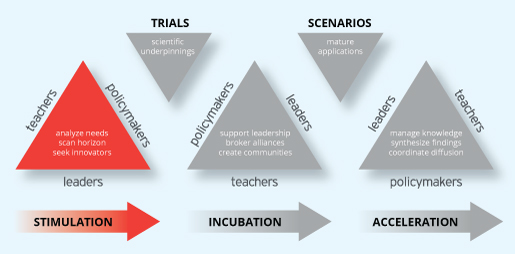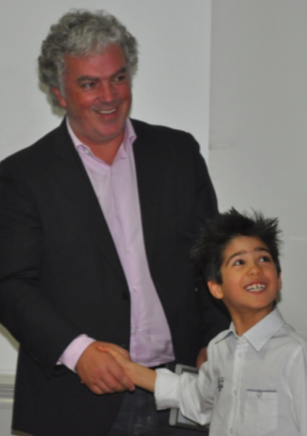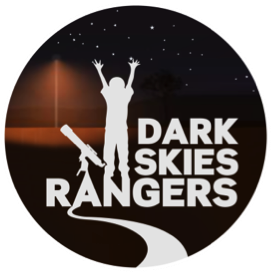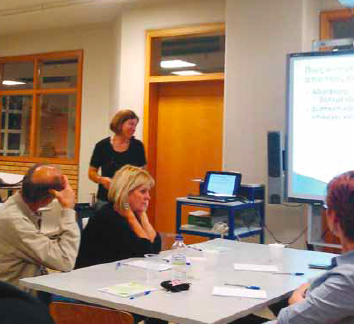

Stimulating: the first key phase in the model
Knowledge of global and local needs and challenges in terms of ICT use and familiarity is a very important step towards the construction of a feasible innovative plan. Scan the horizon to search for best practice examples and optimum resources to support actions that address identified needs. Find innovative examples and partners that can bring new opportunities to the school and change the institutional vision by embracing relevant and engaging new methods and practices. Involvement of the community helps to foster leadership, democratization of opportunities collaboration, network and team building. Receptivity to new ideas is increased by mutual openness among all parties, to collaboratively define and embrace new proposed strategies. Effective communication channels are essential for ensuring proper exchange of ideas and outcomes. |
The stimulation phase is one of the most important in terms of creating the community that will support the trials, pilot the implementation of scenarios, validate and evaluate the usefulness and impact of innovative proposals. Thus, it is important in this phase to involve all participants in the different foreseen activities. A sense of ownership is a crucial motivating element and a step towards the sustainability of the successful changes. An effective stimulation phase must encompass a careful analysis of local needs, review goals given existing possibilities, identify innovative key players and ideas, encourage teambuilding and brainstorming activities to seek out creative options that can be implemented in relation to the identified needs and the capabilities of the team addressing these needs and proposing innovation. |
The importance of developing a shared vision
Innovations that fail to take sufficient time in the stimulation phase risk plowing ahead of the interests and abilities of those who will eventually carry the change in the long term.

The vision of a school towards innovative approaches for teaching and learning processes can only be achieved if solutions are designed in a collaborative environment where all stakeholders actively participate. Stimulating the adoption of innovative ways to solve contemporary (yet often unexplored) emerging needs in schools is a key to success. The stimulus to adopt new or different strategies should follow a planned direction:
- Involve all stakeholders from the start, and acknowledge that the forms of involvement will evolve along with the project.
- Remember to include headmasters, students, teachers, administrative staff, parents and education authorities and policy framers.
- From the very start, consider how to use the following approaches: strengths/weaknesses/opportunities/threats (swot) analysis, needs analysis, solution generation, solution refinement, design and development, attending to factors enabling solutions, and evaluating results and impact even of initial pilot activities.
Innovative schools embrace the challenge to explore unknown and poorly studied new fields. Education and opportunities to learn are changing swiftly and new ways must be adopted in order to ensure schools continue to be key innovative players when preparing new generations for the world of work.
Community building is at the heart of stimulation
The involvement of the school and local community is very important in the stimulation phase. Stakeholders, as mentioned already, have to be part of the innovation from the very start. Promotion of brainstorming sessions can be very useful in fostering support from the community and implementation of good ideas. Holding discussion evenings, forum, social events, and ‘village hall’ debates are excellent methods to initiate discussion of options.
Innovative solutions and best practice examples can be easily found and assessed nowadays with the support of platforms such as ODS. Community support for their adoption is critical in order to overcome any possible existing barriers – which are usually more related to worries and attitudes than they are to technologies themselves. It is of utmost importance that all participant stakeholders have autonomy and the means to research which are the best options and adopt/adapt them to the local identified needs. Potential solutions ideally meet stakeholder needs and also promote student centered methodologies, use freely available content, serve cross curricular connections, have some form of quality assessment, and can be tailored in order to meet specific local needs.
The design phase for stimulating innovative ICT uptake has to take into account needs but also psychological concerns. Most people experience hesitation when dealing with the unfamiliar. The stimulating phase enables stakeholders to gain familiarity with elements of the innovation that could cause concerns, such as tools, pedagogies, or collaborations. By involving stakeholders, familiarity and exposure can lead to trust, ownership and engagement in the whole process.
School participation in projects such as ODS opens up new possibilities for the innovative solution seekers. Support and examples from communities are a key to future implementations. This model and the ODS internet portal offer such ideas.
Learner benefit is the primary added value
We must bear in mind that we are preparing students for future careers that are changing and reshaping the world of work at the speed of light. Career and skill requirements are something that we cannot possibly imagine at this stage. The task of school leadership is to prepare students in the best manner possible to allow them to embrace unanticipated challenges and opportunities in a transformed world. They have to be able to work in inclusive environment, to be tolerant, to have problem solving skills, to be critical thinkers, to be creative and to embrace innovation. They will enter a world of work where they are learning and interacting all the time and will need to be connected anywhere at any time.
Learners only benefit if schools are supported
While the world is changing rapidly, most schools are not. Despite thriving opportunities and extraordinary potential, schools struggle. Teachers lack time to develop ICT skills, schools are poorly equipped, teaching is often limited by rigid and dense curricula, and exams fail to measure use of innovative approaches or acquired competences. Successful innovation attends realistically to the challenges in everyday schools.
| While we seek for innovative projects, most important of all, we seek for innovative minds | ||||
| In any learning environment, we need to identify innovative teachers, those eager to tackle new challenges and not afraid of emerging struggles and opportunities. It is important to provide freedom of choice, tools to adapt and localize their experience and opportunity to freely share their developments and creations. |
|
|||
The profile of such innovators is not rigid - it depends on specific needs and challenges of the target audience. Each school has its own characteristics, each classroom has its own personality and each student will have their own special need. Innovative teachers also have different levels of expertise and projects must seek out for those innovators, eager to adopt a new vision, and take on the mission of adapting existing successes to their own professional development.
Innovative design solutions are a free enterprise and the measures of success are defined for each case. The education revolution is upon us: MOOCs, OER, OCW are the new trends in education. Schools and local communities are adapting to this reality and restructuring accordingly. Pilot innovative teachers are thus key players in this process. Innovative projects encompass interdisciplinary approaches, contextualized teaching, student centered methodologies and involvement of school and local communities. Global citizenship awareness and entrepreneurship are the critical skills and must be in the backbone of any innovative solutions adopted by houses of education.
School innovators explore new ideas with support of others, sharing results, incorporating and remodeling existing knowledge and adapting/localizing and adopting best practices in the field of education.
It is a challenge to try to time-stamp an effective road map for stimulating schools on taking the road of elearning, integration of student centered methodologies in classroom daily practices and the graceful use of ICT as a supporting tool for knowledge delivery, exploration and construction. Many barriers have to be overcome starting with the psychological. It is necessary to ensure each interested party has a sense of ownership of the process. An example of a careful possible design might be by introducing the idea and brainstorming with participants in short workshops where the vision is presented, discussed and improved.
What might stimulation activities look like?
Three examples from the ODS experience
Many initiatives are producing good results on adoption of school elearning and community building. For example, existing ODS experiences have shown that creating thematic communities around specific elearning tools and resources is a very strong motivation factor. The effort promotes community building at a national level but also promotes local practitioner involvement. Schools have become associated in groups under the same school board of directors. Many of the teachers belonging to the same group don't know each other and never collaborated before.
The support of the community has proven key to ensuring sustainability. The Galileo Teacher Training Program is a good example where experts in astronomy train teachers on use of real research in the classroom. Trained teachers, after mastering the use of specific tools and resources, can then train other teachers in a very efficient and sustainable cascade effect. This includes a worldwide help desk that supports teachers 24 hours a day.
| Active students | ||
In Portugal, the theme selected to exploit the Open Discovery Space concept was the fight against light pollution. Light pollution is the direct or indirect introduction of artificial light into the environment. Light pollution competes with starlight in the night sky, interferes with astronomical observatories, disrupts ecosystems and has adverse health effects. In the stimulating phase, a vision-building workshop was promoted around the topic and at a later stage teachers participated in a training workshop. A community was created in the ODS online portal where all materials were shared. As an outcome of this activity, the initial workshop ideas evolved into several scenarios that were created and implemented in various schools in the region. One of the teachers invited another school to collaborate in the project. As a result, students from the new school participated in the experience by creating their own ICT-based material to address the topic. The teacher from the second school presented the work of her students to the ODS international contest promoted by the Portuguese national coordination. Her student won the first prize with a movie asking the mayor of the municipality to change the illumination of the streets to a more user-friendly setting The image here shows the student who won first prize, proudly receiving his certificate from the mayor. The chain of events that lead to his achievement was initiated by the initial activities during the stimulation phase. |
 |
|
Touch the night sky: Astronomy for visually imparied students
Context
In the framework of ODS pilot efforts, and in partnership with other projects (A Touch of the Universe by Astronomical Observatory of the University of Valencia), the project is envisioning a significant contribution towards the adoption of an inclusive approach where blind students work with their non-visually impaired peers and educators. In collaborative settings, they engage in the exploration of content knowledge and use of e-learning tools that can help understand topics that seem, at first, unreachable by students with visual impairment. In the framework of this project, a school in Moimenta da Beira (Portugal), organizer of one of the largest telescope gatherings in the country, promoted a special observing session for blind attendees.
Resources
The project uses materials that can be found in school environments and enrich the experience by the use of freely available ICT tools and an apparatus specially designed for students with special needs. For the observing session, it was necessary to use a thermal printer that reproduced the images that were being acquired by a regular telescope in real time, processed by an image software and printed in a special swelling paper and thermal printer.
Tools
Telescopes, computers, image processing tools, thermal printers.
Scaffolds
Participants where supported by the promoters of the event and the activity was embedded in a regular environment where usual night sky observing sessions take place.
Process
The site was specially chosen for the beauty of its night sky, where light pollution is not yet causing too much damage. Over 50 telescopes from all over the country were gathered at the event. A “special telescope”, devoted for this special public was assembled, connected to a computer and printing the tactile images acquired. Participants with visual impairment were then assisted by educators in order to fully understand the “observed” object and thus having the same full experience that all others were having on site.

Impact
Alongside their non-visually impaired colleagues, they could experience on site and on “real time” the astronomical images collected by the telescopes there present. In terms of innovative ways of reaching audiences that usually don’t attend these events this activity has proven to be a success gathering visually impaired and sighted students in a fully inclusive experience in terms of physical, social and knowledge acquisitions.
Lessons learned
The main goal was fully and successfully achieved - to showcase the possibility to involve blind students in purely observational and sight based experiences, otherwise inaccessible to blind or visually impaired audiences. Promoting an environment of collaboration and exchange of knowledge between educators and among the students themselves, sustaining peer-to-peer exploration and support, all students explored the tactile images observed (whether by sight or touch).
| Dark Skies Rangers: Building communities and creating awareness | ||
| Context Policy towards school administration in Portugal has been changing drastically over the last few years. Schools in the same region are now aggregated in big groups with the school main headquarters being located in one of the schools, usually the most central one in terms of geographical importance. Most groups have now schools ranging from primary to secondary level. Teachers have now to teach in the various establishments of the group and facilities are now shared by a larger number of users. This has brought new challenges to school boards and now demands new dynamics in terms of a common vision, well-orchestrated mission, design and activity implementation. Many of the educators of the same group, even within the same subject area, don’t know each other. In order to support the team building and community building in this new groups, ODS-Portugal engaged in supporting teachers in the mission of promoting interschool projects. The theme of choice was the fight against light pollution. |
 |
|
Resources Tools Scaffolds Process Impact Lessons learned |
||
Promising practices in the stimulation phase
Each context offers its own opportunities and hosts unique constraints. While adjustments are required for all settings, the four practices described below have been tailored for use in multiple settings with both pleasant and productive outcomes. |
 |
Vision-building workshops
Several such events must take place in order to involve as many people as possible. Some initial participants will then participate in a pilot trial. The vision-building workshops are brainstorming sessions involving all the important stakeholders in the creative process.
Training workshops
Following the initial teaser, participants are invited to create their own learning scenarios, using OER and ICT for a particular topic they are interested in and/or to use already existing ones, already tested in other schools/classrooms. These sessions will promote a sense of support and community building will take place.
On site demos and awareness campaigns
Activities that involve the whole school and local community are promoted, though of course time intervals between all actions vary according to the objectives and concrete implementation phase of each project. In demos, students and teachers gain first-hand experiences with innovative tools. Also, school and local community is welcomed to get involved in the innovation process taking place at school.
Establish a recognition system
Endorsing the work implemented and the achieved results is advisable. The whole path should be carefully designed and participants can then have a sense of the overall mission they are committing to and can evaluate their own progress.


